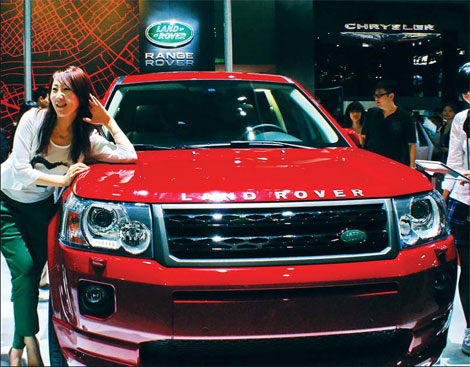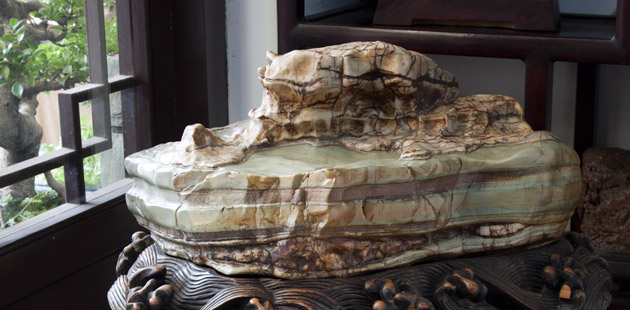Locals often lag in joint venture 'localization'
Updated: 2011-12-12 16:06
By Jenny Gu (China Daily)
|
|||||||||||
Foreign partners still control branding, R&D, lineup and networks
Surging demand for luxury vehicles has seen many premium brands make China their second home.
|
 |
|
Following the path of Audi, BMW and Mercedes, Land Rover might be the next premium brand with local production.[Phpto/China Daily] |
Even those that don't currently have a strong foothold are increasingly eyeing China as a key engine for future growth.
But to truly establish themselves in the market, they have to localize.
As some global automakers and their local partners are busy ramping up production of localized luxury models, many other foreign carmakers are seeking Chinese partners, as is required by the government, to set up new joint ventures. Lexus, Infiniti and Land Rover are among those considering localization in China in the near future.
Localization made slow progress before 2009. From 2005 to 2009, the number of China-made luxury models only increased by one - from eight to nine. That began to change in 2010, when the number climbed to 11, and is now expected to reach 15 by 2012.
We expect 22 luxury models to be locally built by 2015, when they will account for 60 percent of the segment's sales, compared to 56 percent in 2009.
While the pursuit of profits drives both foreign brands and their local partners to look to localization, a change in regulation on import duties in September 2009 accelerated the process.
Before the change, there was no tax difference whether foreign brands imported complete vehicles or components for assembly in China, as both were charged 25 percent. Now importers of complete vehicles continue to pay the same rate of 25 percent while those importing components pay just 10 percent.
In the past, foreign brands didn't have to share profit with their local partners when importing complete vehicles, but now they are pushed to produce more vehicles at the JVs with more components either locally sourced or imported to lower the cost.
They can also lower the risk of exchange rate fluctuations through local sourcing. Consequently, there is now a greater share of profits for local partners.
The makers of luxury vehicles now see their joint ventures as more of an assembly operation, while they take charge of all the core functions - brand strategy, R&D, product lineup and dealer networks.
Weak local partners
Because of this, luxury brands tend to look for local partners who are weak in market share or brand power, but eager to boost their image through cooperation with foreign automakers.
BMW, for instance, selected Brilliance Auto, while Daimler chose Beijing Automotive Industry Group (BAIC). Weak performers in the market, both Brilliance and BAIC apparently expected the foreign luxury makers to help make their brands stronger.
Yet after several years of cooperation, the joint ventures have boomed but the local partners have felt little direct impact.
But the joint ventures have become core assets for local partners as they rely heavily on the profits and technology from the partnership.
Interestingly, Brilliance Auto peeled off its own Zhonghua car business from its Hong Kong-listed company in 2009 because it had lost money for two consecutive years.
The performance of the BMW brand in China then became the indicator for Brilliance Auto's stock.
Similarly, BAIC considered its joint venture with Daimler a core asset when it was preparing for listing on the A-share market.
BAIC's own car business started operations in 2010, though it has yet to launch any new models. Daimler took control of the JV, deciding the product mix, brand strategy and marketing. BAIC, the weaker partner, has had little influence in the JV's decision-making process.
Land Rover could be the next with its potential partner Chery. Land Rover likely to take the lead on branding and technology.
But JVs do not reflect the original intention of the Chinese government's regulations.
The government encourages localization, which was supposed to include the whole value chain, not just a factory. But while local partners may be able to fully participate in the R&D, production and human resource systems, such cases are rare.
Local makers obviously realize the problem and are trying to deepen their cooperation with the luxury brands. They understand there is more than just profit and short-term benefits and that know-how and qualified talent are the fundamentals for long-term development.
Zhonghua Car is often criticized for its light product lineup and lack of R&D capability. But we have heard that BMW will transfer the current 3 Series platform to Brilliance after the new generation model is launched. This could happen in about three years. Brilliance Auto has been working hard to improve its business.
Similarly, we also heard that the strategy to develop an independent brand might used in Chery and Land Rover partnership, which should help Chery get the technology it needs to grow.
We are happy to see the local manufacturers making efforts to further develop, but there are still concerns.
Without qualified talent, Zhonghua might find it difficult to make full use of the advanced technology it will be adopting and ultimately choose to just duplicate previous products.
Technology and talent are like hardware and software- for the hardware to be utilized effectively and fruitfully, it needs to be supported by quality software.
The author is a senior analyst at JD Power and Associates and LMC Automotive, who can be reached at jgu@lmc-auto.com








